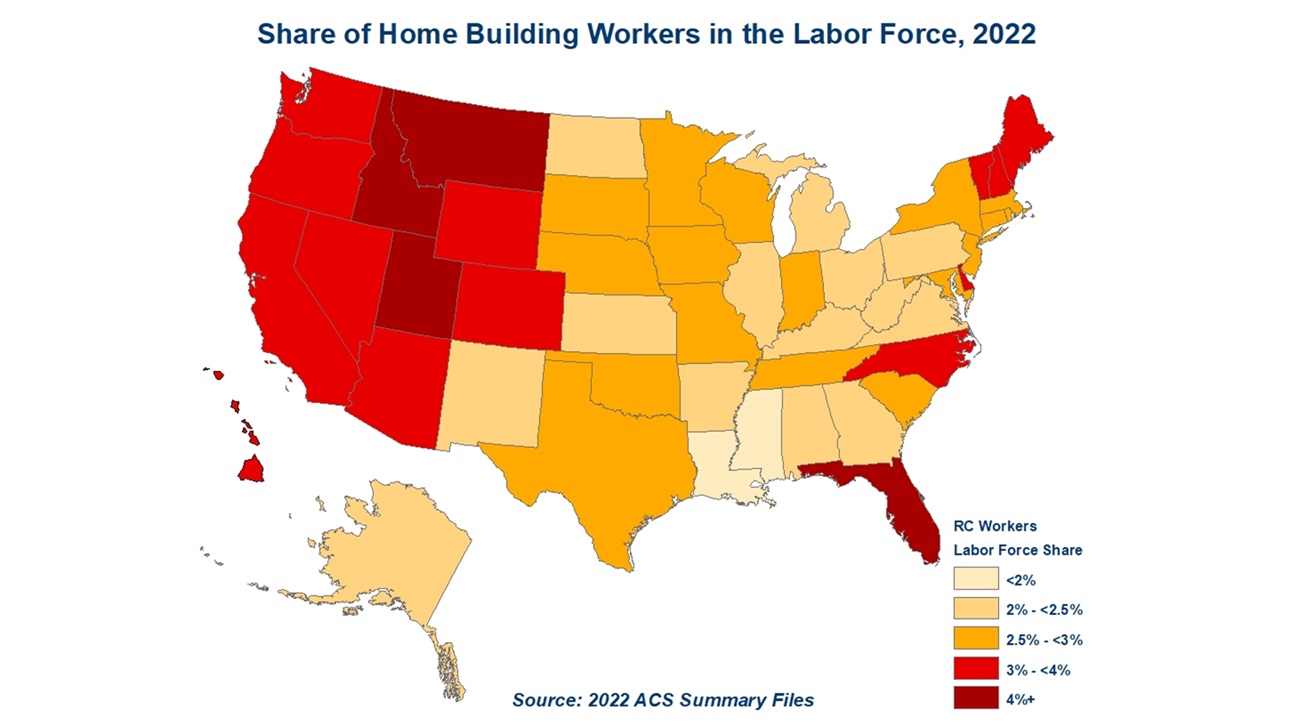How Many People Work in Residential Construction in Your State?
According to the latest American Community Survey, 11.2 million people — including self-employed workers — worked in construction in 2022. NAHB estimates that, out of this total, 4.7 million people worked in residential construction, accounting for 2.9% of the U.S. employed civilian labor force.
Not surprisingly, the most populous state — California — also has the most residential construction workers. Over 650,000 California residents worked in home building in 2022, accounting for 3.4% of the state employed labor force.
In terms of percentages, fast-growing states with a high prevalence of seasonal, vacation homes top the list of states with the highest share of residential construction workers in 2022. Three states in the Mountain Division — Idaho, Utah, and Montana — take the top spots on the list with 5.9%, 5.4% and 4.8%, respectively, of the employed labor force working in home building. Florida — which has registered one of the fastest growing populations since the start of the pandemic — is next on the list with a share of 4.4%, down from its peak in 2006 at 6.5%.
In addition, 10 other states register shares of residential construction workers that approach 4%:
- Maine (3.9%),
- Wyoming (3.8%),
- Vermont (3.8%),
- Washington, Colorado, New Hampshire and Nevada (3.7%), and
- Arizona, North Carolina, and Oregon (3.5%).

NAHB’s analysis also identifies congressional districts where home building accounts for particularly high employment levels and share of local jobs. As of 2022, the average congressional district has about 10,800 residents working in residential construction, but that number is often significantly higher. For example, in Idaho’s 1st Congressional District, more than 29,000 residents are in home building, and Idaho’s 2nd Congressional District has close to 25,000 residents working in home building.
Eight other congressional districts have over 20,000 residents working in residential construction:
- Florida’s 26th Congressional District (24,700),
- Utah’s 4th Congressional District (24,500),
- Utah’s 2nd Congressional District (24,300),
- Florida’s 17th Congressional District (21,400),
- Utah’s 1st Congressional District (20,600),
- Florida’s 7th Congressional District (20,500),
- California’s 29th Congressional District (20,400), and
- Colorado 8th Congressional District (20,100).
By design, Congressional districts are drawn to represent roughly the same number of people. So generally, large numbers of residential construction workers translate into high shares of residential construction workers in their district employed labor forces.
Natalia Siniavskaia, assistant vice president for housing policy research at NAHB, provides more details and analysis in this Eye on Housing post.
Latest from NAHBNow
Jan 02, 2026
Trump Delays Higher Tariffs on Furniture, Kitchen Cabinets for One YearPresident Trump has announced he will be rolling back higher tariffs on furniture, kitchen cabinets and vanities that were set to go into effect on Jan. 1, 2026, until Jan. 1, 2027.
Jan 02, 2026
FHA’s MMI Fund Capital Ratio Remained Solid in Fiscal Year 2025The capital reserve ratio for the Federal Housing Administration’s Mutual Mortgage Insurance Fund ended the fiscal year at 11.47% — unchanged from the capital ratio for fiscal year 2024 and well above the congressionally mandated 2% capital ratio.
Latest Economic News
Dec 22, 2025
State-Level Employment Situation: September 2025In September 2025, nonfarm payroll employment was largely unchanged across states on a monthly basis, with a limited number of states seeing statistically significant increases or decreases. This reflects generally stable job counts across states despite broader labor market fluctuations. The data were impacted by collection delays due to the federal government shutdown.
Dec 19, 2025
Existing Home Sales Edge Higher in NovemberExisting home sales rose for the third consecutive month in November as lower mortgage rates continued to boost home sales, according to the National Association of Realtors (NAR). However, the increase remained modest as mortgage rates still stayed above 6% while down from recent highs. The weakening job market also weighed on buyer activity.
Dec 18, 2025
Lumber Capacity Lower Midway Through 2025Sawmill production has remained essentially flat over the past two years, according to the Federal Reserve G.17 Industrial Production report. This most recent data release contained an annual revision, which resulted in higher estimates for both production and capacity in U.S. sawmills.
